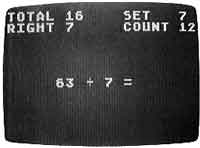Bonus Game
Math Flashcards
Arithmetic drill that kids really use
by Andy Barton
 Math Flashcards is a direct, no-nonsense arithmetic flashcard program that kids enjoy using. This BASIC program works on all 8-bit Atari computers of any memory size, with disk or cassette.
Math Flashcards is a direct, no-nonsense arithmetic flashcard program that kids enjoy using. This BASIC program works on all 8-bit Atari computers of any memory size, with disk or cassette.
There are many elementary-school arithmetic programs for the Atari. I have four or five myself, but my children wonít use them. The kids have outgrown the count-the-dots programs, theyíre frightened off by the competitive programs, or they play with the flashing colors and dancing creatures and donít learn the math.
Arithmetic Flashcards is a simple, straightforward, non-competitive math program designed to help children learn the primary arithmetic tables for addition, subtraction, multiplication and division. Itís interesting, but not flashy. A little randomized music routine rewards each correct answer, a slightly longer routine plays after each set is successfully completed, and a long routine sounds after nine sets are finished.
The emphasis is on repetition. In each set the child must get 15 consecutive problems correct before advancing. If the child gets an answer wrong, the screen turns red, the count is reset to 15 and the child must come up with the correct answer before continuing. The missed problem is repeated three times on an orange screen alternated with new problems.
Speed is important. If there is no answer given within 20 seconds a buzzer sounds and the error routine begins. Every 20 seconds the buzzer gets longer until a "Get Going" message prods the child on.
The program is aimed at learning, not at making mistakes. The number of correct answers and the total number tried are displayed. But the number of errors is not directly monitored. I did make one concession to my kids. The program allows them to skip easy sets by choosing the set they wish to start with.
GETTING STARTED
Type in Listing 1, FLASH.BAS, check it with TYPO Il and SAVE a copy before you RUN it.If you have trouble typing in the special characters in line 10070, donít type them in. Listing 2 will create them for you. Type Listing 2, checking it with TYPO II, and SAVE a copy to disk or cassette. When RUN, Listing 2 will ask you whether you are using a disk drive or a cassette. Next, the program creates these hard-to-type lines, and stores them in an disk file called D:LINES.LST (for disk owners) or to a fresh cassette tape.
To merge the two programs, LOAD Listing 1, "D:FLASH.BAS" then ENTER "D:LINES.LST". (Cassette owners should CLOAD Listing 1, then insert the tape file created by Listing 2 and type ENTER "C:").
Finally, remember to SAVE the completed program before you RUN it.
CUSTOMIZING
To accommodate your individual needs and style, several variables were used to make it easy for the inexperenced programmer to customize Math Flashcards. Change the value of the following variables as you wish and RUN the program. When you are satisfied with your changes SAVE it back to disk.In line 10240, COUNT determines the number of consecutive correct answers needed to go on to the next set. SET determines the number table that the program will start at. The option of choosing the starting set can be eliminated by deleting lines 10200 through 10220 and giving SET a value from one to nine.
In line 10250, TLIM sets the time limit for typing the answer. A value of one is extremely quick, about four seconds, and a value of five allows about 20 seconds. REPEAT sets the number of times a missed problem is repeated.
Line 10260—CTUNE, STUNE, and ETUNE are the number of notes played after a correct answer, after each set and after set nine. BUZZ is the length of time the buzzer sounds for a wrong answer. BUZZ is converted to PAUSE which is increased in line 70 to determine if, in line 80, the "Speed Up" message is printed.
Andy Barton of San Carlos, California is the author of TYPO II, which has appeared in every issue of Antic since January, 1985.
Listing 1 FLASH.BAS Download